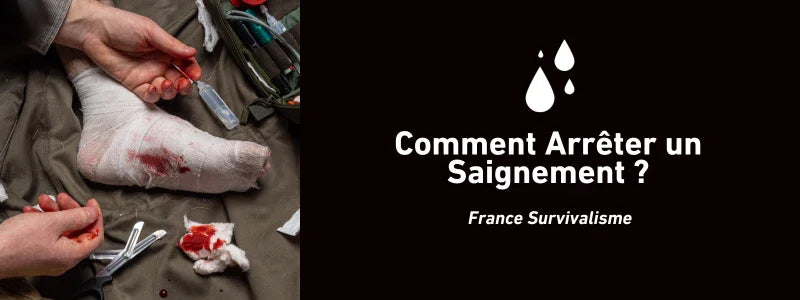In a survival situation, every second counts, especially when it comes to treating bleeding. Knowing how to stop bleeding quickly can mean the difference between life and death. This article guides you through the essential steps to effectively manage bleeding in a survival setting.
I. Recognizing Types of Bleeding
- Arterial Bleeding : Blood gushes out of the wound, often bright red in color. This type of bleeding is the most dangerous and requires rapid intervention.
- Venous Bleeding : Less intense than arterial bleeding, the blood flows continuously and is dark red in color.
- Capillary Bleeding : The most common and least serious, it is characterized by a slow and continuous flow.
II. First Steps to Take
- Assess Safety : Make sure you and the victim are safe before intervening.
- Stay Calm : Stay calm so you can think clearly and act effectively.
- Situation Assessment : Determine the severity of the bleeding and the type of injury.

III. Techniques to Stop Bleeding
-
Direct Compression :
- Use a clean bandage or piece of cloth.
- Apply direct, continuous pressure to the wound.
- If blood leaks through the dressing, do not remove the first one, but add another on top.
- Continue applying pressure until the bleeding stops.
-
Elevation of the Affected Limb :
- Elevate the injured limb above heart level.
- This position helps reduce blood flow to the injury.
IV. Making a Tourniquet of Fortune
-
When to Use a Tourniquet :
- Only if direct compression and elevation does not work.
- In case of profuse and uncontrollable bleeding from a limb.
-
How to Make a Tourniquet :
- Use a bandage, scarf or other sturdy piece of fabric.
- Place it a few centimeters above the wound (not directly on it).
- Squeeze until the bleeding stops, but be careful not to cut off circulation completely.
V. Infection Prevention
-
Cleaning the Wound :
- Clean the wound with clean water to reduce the risk of infection.
- Avoid using dirty or questionable water, as this can make the infection worse.
-
Disinfection :
- If available, use a mild disinfectant or saline solution to further clean the wound.
- Apply a thin layer of antibiotic ointment, if you have it.
-
Monitoring for Signs of Infection :
- Monitor the wound for signs of infection, such as redness, warmth, swelling, or purulent discharge.
- See a doctor as soon as possible if you suspect an infection.
VI. Preparation and Training
-
First Aid Kit :
- Make sure you have a well-equipped first aid kit in your survival gear.
- Include bandages, antiseptics, antibiotic ointments and tools for making a tourniquet.
-
First Aid Training :
- Invest time in first aid training.
- Skills such as CPR (cardiopulmonary resuscitation) and treating serious injuries are essential in a survival situation.
